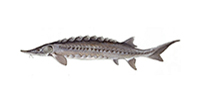Thank you for visiting the Seafood Selector. EDF is planning a new approach to providing information to consumers about good seafood choices. Please come back soon for updates.
Sturgeon

Sturgeon
Recommended servings per month
| Contaminant | Men | Women | Kids 6-12 | Kids 0-5 | |
|---|---|---|---|---|---|
| Atlantic sturgeon | Mercury | 4+ | 4+ | 4+ | 4+ |
| White sturgeon (wild, OR and WA) | Mercury | 4+ | 4+ | 3 | 2 |
| White sturgeon (farmed) | Unknown | 4 | 4 | 4 | 4 |
| Beluga sturgeon | Mercury, *PCBs | 3 | 3 | 2 | 1 |
| Lake sturgeon | Mercury, *PCBs | 3 | 3 | 2 | 1 |
| Russian sturgeon | Mercury, *PCBs | 3 | 3 | 2 | 1 |
| Stellate sturgeon | Mercury, *PCBs | 3 | 3 | 2 | 1 |
| Sturgeon (wild, imported) | Mercury, *PCBs | 3 | 3 | 2 | 1 |
Eco details:
Most wild populations of sturgeon are severely depleted as a result of pollution, habitat degradation and overfishing. Intense international demand for high-priced caviar has driven the species to near extinction in the Caspian Sea region (Beluga, Russian/Osetra, Stellate/Sevruga).
Farmed white sturgeon are environmentally preferable to wild sturgeon from the Caspian Sea region.




